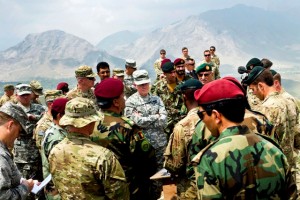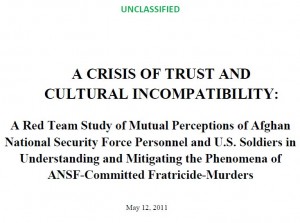Multiple Attacks in Kandahar Area Include at Least Two by Attackers in Afghan Police Uniforms
The last 24 hours or so have seen multiple attacks carried out in the Kandahar area. It appears that at least two of them were carried out by men wearing Afghan police uniforms. Only one of these two attacks is now being described as a “green on blue” attack, while the other is described as being carried out by insurgents wearing Afghan police uniforms.
ISAF has released this terse statement about the confirmed green on blue attack that occurred yesterday:
KABUL, Afghanistan (June 19, 2012) — The International Security Assistance Force confirms that three individuals in Afghan Police uniforms turned their weapons against coalition service members in southern Afghanistan yesterday, killing one ISAF service member.
The three individuals immediately fled the area and are currently being sought.
The incident is under investigation.
That statement, however, is indicated to be an “update” to an earlier statement which reads:
An International Security Assistance Force service member died of wounds following an insurgent attack in southern Afghanistan today.
Note that the initial report merely cites “an insurgent attack” while the follow-up says the attack was by “three individuals in Afghan police uniforms”. That sequence of events is important for considering the current reports on the additional attacks around Kandahar.
Here is the New York Times description of the attack today which is described as involving Afghan police uniforms:
Taliban insurgents wearing police uniforms attacked a checkpoint in southern Afghanistan on Tuesday, killing three police officers, local officials said.
NATO confirmed the attack and said fighting was continuing.
The militants’ attack on a police checkpoint in the southwestern of Kandahar city near a major prison left another seven officers wounded, according to the Kandahar governor’s office. Javed Faisal, a spokesman for the governor of Kandahar, said four of the insurgents were killed in the fighting.
A police officer who said he witnessed the fighting said Taliban insurgents first attacked the Afghan police checkpoint and then attacked nearby NATO troops, who returned fire. The police officer did not want to be identified because he was not authorized to speak to the media.
How do “Taliban insurgents” come to be in possession of Afghan police uniforms? Are these personnel who trained as police and then went over to the Taliban, taking their uniforms with them? Have the Taliban somehow found a supply of Afghan police uniforms other than from those who leave the police force?
At any rate, given how yesterday’s attack went from being merely an insurgent attack to an attack by individuals in Afghan police uniforms, it will be very interesting to see what additional information comes from the investigation into those involved in today’s attack.
But today’s attack that involved Afghan police uniforms appears to be just one of at least three attacks in the Kandahar area. From the Washington Post: Read more →



